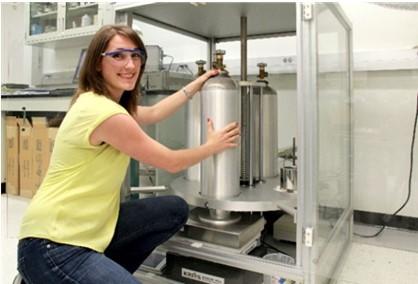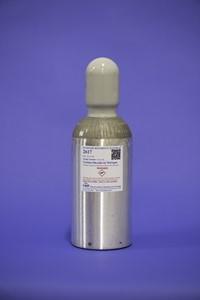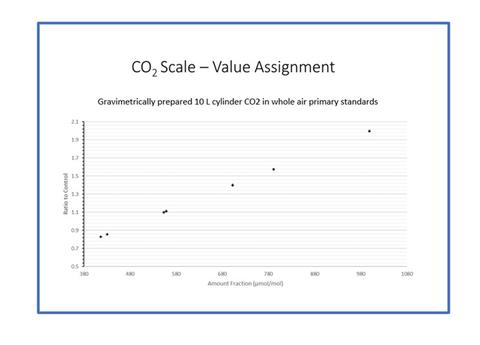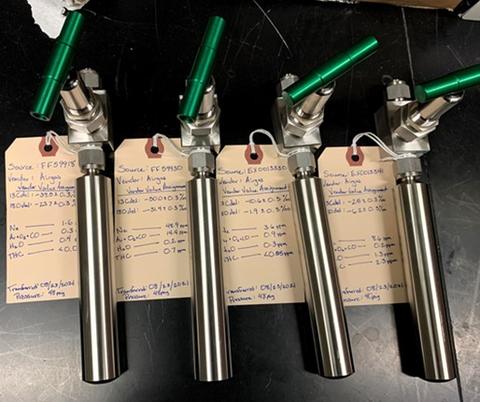Summary

The Gas Sensing Metrology Group at NIST develops primary gravimetric standards for a wide variety of CO2 measurement uses. For the past 40+ years the group has utilized these primary standard mixtures (PSMs) to provide CO2 standard reference materials (SRMs) and NIST Traceable Reference Materials (NTRMs) ultimately used to support measurements in atmospheres (urban, rural, and pristine) and process streams (automobile and stack). Concentration of standards range from ambient level to percent level. In recent years, additional work has begun to develop a NIST CO2 Scale and to develop isotopically assigned CO2 reference materials. Currently we are working towards developing reference materials for ocean carbon cycle measurements.
Description
CO2 Reference Materials

The Gas Sensing Metrology Group at NIST has a long history of providing reference materials to industry, monitoring communities, and academia. The program began in the 1970’s by developing an initial suite of CO2 primary standard mixtures (PSMs) to support the US Department of Energy and emissions gas measurements. Through the 1980’s and 1990’s a second suite of CO2 PSMs was developed along with seven CO2/Air standard reference materials (SRMs), all individually certified, to meet customer needs for reference materials. In the 2000’s, a major expansion of CO2 PSM suites occurred using higher purity starting materials. Advances in analytical instrumentation also led to the ability to begin to study adsorption/desorption issues in the internal surface walls of compressed gas cylinders. In the 2010’s a review of stability data showed that early CO2 PSMs (0.5% relative uncertainties) were considered stable, but new CO2 PSMs (0.05% relative uncertainties) showed an increase in mole fraction dependent on cylinder pressure and volume to surface ratio. During this time, two new real air SRMs representing Northern Continental Air and Southern Oceanic Air were developed as a collaboration with National Oceanic and Atmospheric Administration (NOAA). Today, NIST offers nine different CO2/N2 SRMs ranging in concentration from 500 µmol/mol to 16% and two CO2/Air SRMs at ambient concentrations.
CO2 Scale

Atmospheric monitoring applications require a high degree of consistency among CO2 calibration standards. Currently, primary gas standards, produced using a gravimetric preparation method providing traceability to the SI, have standard uncertainties that are too high to be used to make measurements where small temporal and spatial changes are important. An international task group, being led by NIST under the Metre Convention structure, has been convened to develop a system to more efficiently disseminate accurate and consistent greenhouse gas (GHG) standards due to an expected increased demand based on proliferating atmospheric GHG measurements globally.
The Gas Sensing Metrology Group is developing a new suite of CO2/Air PSMs ranging in concentration from nominal 374 µmol/mol to 999 µmol/mol which will be used to establish a NIST CO2 Scale. The NIST CO2 Scale will consist of a suite of 8 working standards ranging in concentration from nominal 385 µmol/mol to 895 µmol/mol CO2. Values for CH4, N2O, Ar, and O2 will also be assigned. This scale will be internationally compared using the CIPM MRA process and a relationship will be established to a common scale, for example the WMO-Scale, for interpretation of combined datasets.
A two-step dilution scheme is also being developed and tested to allow for a more efficient method of preparing and replacing depleted CO2 PSMs. To evaluate equivalency of PSMs, comparison studies are routinely performed both at the domestic level and at the international level.
Isotope Ratios in CO2

The emergence of high-precision optical analyzers coupled to traditional mass spectrometry measurements of isotope ratios has led to an increased demand in the atmospheric community for isotope reference materials of known composition and uncertainty. Amongst the analytes of interest for reference materials and measurements, CO2 is of key importance to industry, central calibration laboratories (CCLs), national metrology institutes (NMIs) and the Bureau International des Poids et Mesures (BIPM). The acceptance criterion of these efforts can be traced to the World Metrological Organization/Global Atmospheric Watch (WMO/GAW) set compatibility metrics on the isotope-ratio-related values, δ13C and δ18O, across measurement techniques.
The Gas Sensing Metrology Group is developing two suites of CO2 PSMs, one in synthetic air and one in whole air utilizing pure CO2 that has been isotopically characterized to the Vienna Peedee Belemnite (VPDB) Scale for δ13C-VPDB-CO2 and δ18O-VPDB-CO2. Utilizing cavity ring down spectroscopy (CRDS) and tunable infrared laser direct absorption spectroscopy (TILDAS) we will characterize these PSMs over a physically relevant range of isotope values. These CO2 PSMs will then be used to transfer isotopic values to existing CO2/Air SRMs.
CO2 Ocean
Ocean carbon chemistry is changing as a result of human activities making seawater CO2 measurements critical to ocean carbon monitoring efforts. As more countries increase ocean observation efforts and newer technologies such as ocean carbon dioxide removal are being developed, the demand for these reference materials will likely increase. The Gas Sensing Metrology Group, in coordination with the Inorganic Chemical Metrology Group, is working towards developing capabilities to provide services for the analysis of total dissolved inorganic carbon using CO2/Air primary standard materials (PSMs) to provide SI traceability.
Associated Publications
1. Jahrman, E. P., Masias, K. L. S., Peck, T. C., and Roberts, C. A., "X-ray absorption fine structure characterization of a multicomponent spinel catalyst," X-Ray Spectrometry, 52, 90-101 (2023).
2. Guallart, E. F., Fajar, N. M., Garcia-Ibanez, M. I., Castano-Carrera, M., Santiago-Domenech, R., Hassoun, A. E., Perez, F. F., Easley, R. A., and Alvarez, M., "Spectrophotometric Measurement of Carbonate Ion in Seawater over a Decade: Dealing with Inconsistencies," Environ. Sci. Technol., 56, 7381-7395 (2022).
3. Long, D. A., Adkins, E. M., Mendonca, J., Roche, S., and Hodges, J. T., "The effects of advanced spectral line shapes on atmospheric carbon dioxide retrievals," Journal of Quantitative Spectroscopy & Radiative Transfer, 291, (2022).
4. Srivastava, A., "Physical model for multi-point normalization of dual-inlet isotope ratio mass spectrometry data," Analytical and Bioanalytical Chemistry, 414, 5773-5779 (2022).
5. Adkins, E. M., Long, D. A., and Hodges, J. T., "Air-broadening in near-infrared carbon dioxide line shapes: Quantifying contributions from O-2, N-2, and Ar," Journal of Quantitative Spectroscopy & Radiative Transfer, 270, (2021).
6. Fleisher, A. J., Yi, H. M., Srivastava, A., Polyansky, O. L., Zobov, N. F., and Hodges, J. T., "Absolute C-13/C-12 isotope amount ratio for Vienna PeeDee Belemnite from infrared absorption spectroscopy," Nature Physics, 17, 889-+ (2021).
7. Karlovets, E. V., Gordon, I. E., Rothman, L. S., Hashemi, R., Hargreaves, R. J., Toon, G. C., Campargue, A., Perevalov, V. I., Cermak, P., Birk, M., Wagner, G., Hodges, J. T., Tennyson, J., and Yurchenko, S. N., "The update of the line positions and intensities in the line list of carbon dioxide for the HITRAN2020 spectroscopic database," Journal of Quantitative Spectroscopy & Radiative Transfer, 276, (2021).
8. Reed, Z. D., Drouin, B. J., Long, D. A., and Hodges, J. T., "Molecular transition frequencies of CO2 near 1.6 mu m with kHz-level uncertainties," Journal of Quantitative Spectroscopy & Radiative Transfer, 271, (2021).
9. Reed, Z. D., Drouin, B. J., and Hodges, J. T., "Inclusion of the recoil shift in Doppler-broadened measurements of CO2 transition frequencies," Journal of Quantitative Spectroscopy & Radiative Transfer, 275, (2021).
10. Fleurbaey, H., Yi, H. M., Adkins, E. M., Fleisher, A. J., and Hodges, J. T., "Cavity ring-down spectroscopy of CO2 near lambda=2.06 mu m: Accurate transition intensities for the Orbiting Carbon Observatory-2 (OCO-2) "strong band"," Journal of Quantitative Spectroscopy & Radiative Transfer, 252, (2020).
11. Li, X. Y., Garcia-Ibanez, M. I., Carter, B. R., Chen, B. S., Li, Q., Easley, R. A., and Cai, W. J., "Purified meta-Cresol Purple dye perturbation: How it influences spectrophotometric pH measurements," Marine Chemistry, 225, (2020).
12. Long, D. A., Reed, Z. D., Fleisher, A. J., Mendonca, J., Roche, S., and Hodges, J. T., "High-Accuracy Near-Infrared Carbon Dioxide Intensity Measurements to Support Remote Sensing," Geophysical Research Letters, 47, (2020).
13. Payne, V. H., Drouin, B. J., Oyafuso, F., Kuai, L., Fisher, B. M., Sung, K., Nemchick, D., Crawford, T. J., Smyth, M., Crisp, D., Adkins, E., Hodges, J. T., Long, D. A., Mlawer, E. J., Merrelli, A., Lunny, E., and O'Dell, C. W., "Absorption coefficient (ABSCO) tables for the Orbiting Carbon Observatories: Version 5.1," Journal of Quantitative Spectroscopy & Radiative Transfer, 255, (2020).
14. Reed, Z. D., Long, D. A., Fleurbaey, H., and Hodges, J. T., "SI-traceable molecular transition frequency measurements at the 10(-12) relative uncertain level," Optica, 7, 1209-1220 (2020).
15. Brewer, P. J., Kim, J. S., Lee, S., Tarasova, O. A., Viallon, J., Flores, E., Wielgosz, R. I., Shimosaka, T., Assonov, S., Allison, C. E., van der Veen, A. M. H., Hall, B., Crotwell, A. M., Rhoderick, G. C., Hodges, J. T., Mahn, J., Zellweger, C., Moossen, H., Ebert, V., and Griffith, D. W. T., "Advances in reference materials and measurement techniques for greenhouse gas atmospheric observations," Metrologia, 56, (2019).
16. Fleisher, A. J., Adkins, E. M., Reed, Z. D., Yi, H. M., Long, D. A., Fleurbaey, H. M., and Hodges, J. T., "Twenty-Five-Fold Reduction in Measurement Uncertainty for a Molecular Line Intensity," Physical Review Letters, 123, (2019).
17. Mendonca, J., Strong, K., Wunch, D., Toon, G. C., Long, D. A., Hodges, J. T., Sironneau, V. T., and Franklin, J. E., "Using a speed-dependent Voigt line shape to retrieve O-2 from Total Carbon Column Observing Network solar spectra to improve measurements of XCO2," Atmospheric Measurement Techniques, 12, 35-50 (2019).
18. Plusquellic, D. F., Wagner, G. A., Briggman, K., Fleisher, A. J., Long, D. A., and Hodges, J. T., "Simultaneous DIAL, IPDA and point sensor measurements of the greenhouse gases, CO2 and H2O," 2019 Conference on Lasers and Electro-Optics (Cleo), (2019).
19. Fleisher, A. J., Long, D. A., and Hodges, J. T., "Quantitative modeling of complex molecular response in coherent cavity-enhanced dual-comb spectroscopy," Journal of Molecular Spectroscopy, 352, 26-35 (2018).
20. Reed, Z. D., Long, D. A., Kyuberis, A., Polyansky, O., and Hodges, J. T., "Reducing Uncertainties of Molecular Line Intensities Via Cavity Ring-Down Spectroscopy Measurements and Ab Initio Calculations," Igarss 2018 - 2018 Ieee International Geoscience and Remote Sensing Symposium, 4324-4327 (2018).
21. Rhoderick, G. C., Kelley, M. E., Miller, W. R., Norris, J. E., Carney, J., Gameson, L., Cecelsld, C. E., Harris, K. J., Goodman, C. A., Srivastava, A., and Hodges, J. T., "NIST Standards for Measurement, Instrument Calibration, and Quantification of Gaseous Atmospheric Compounds," Analytical Chemistry, 90, 4711-4718 (2018).
22. Srivastava, A. and Verkouteren, R. M., "Metrology for stable isotope reference materials: C-13/C-12 and O-18/O-16 isotope ratio value assignment of pure carbon dioxide gas samples on the Vienna PeeDee Belemnite-CO2 scale using dual-inlet mass spectrometry," Analytical and Bioanalytical Chemistry, 410, 4153-4163 (2018).
23. Yi, H. M., Srivastava, A., Fleisher, A. J., and Hodges, J. T., "Rapid Scanning Cavity Ring-down Spectrometer for the Precision Measurement of C-13/C-12 for CO2 in Air," 2018 Conference on Lasers and Electro-Optics (Cleo), (2018).
24. Yi, H. M., Liu, Q. N., Gameson, L., Fleisher, A. J., and Hodges, J. T., "High-accuracy (CO2)-C-12-O-16 line intensities in the 2 mu m wavelength region measured by frequency-stabilized cavity ring-down spectroscopy," Journal of Quantitative Spectroscopy & Radiative Transfer, 206, 367-377 (2018).
25. Bailey, D. M., Adkins, E. M., and Miller, J. H., "An open-path tunable diode laser absorption spectrometer for detection of carbon dioxide at the Bonanza Creek Long-Term Ecological Research Site near Fairbanks, Alaska," Applied Physics B, 123, 1-10 (2017).
26. Ghysels, M., Liu, Q. N., Fleisher, A. J., and Hodges, J. T., "A variable-temperature cavity ring-down spectrometer with application to line shape analysis of CO2 spectra in the 1600 nm region," Applied Physics B-Lasers and Optics, 123 , (2017).
27. Reed, Z. D. and Hodges, J. T., "High precision 2.0 mu m Photoacoustic Spectrometer for Determination of the (CO2)-C-13/(CO2)-C-12 Isotope Ratio," 2017 Conference on Lasers and Electro-Optics (Cleo), (2017).
28. Fleisher, A. J., Long, D. A., Reed, Z. D., Hodges, J. T., and Plusquellic, D. F., "Coherent cavity-enhanced dual-comb spectroscopy," Optics Express, 24, (2016).
29. Rhoderick, G. C., Kitzis, D. R., Kelley, M. E., Miller, W. R., Hall, B. D., Dlugokencky, E. J., Tans, P. P., Possolo, A., and Carney, J., "Development of a Northern Continental Air Standard Reference Material," Analytical Chemistry, 88, 3376-3385 (2016).
30. Lin, H., Reed, Z. D., Sironneau, V. T., and Hodges, J. T., "Cavity ring-down spectrometer for high-fidelity molecular absorption measurements," Journal of Quantitative Spectroscopy & Radiative Transfer, 161, 11-20 (2015).
31. Long, D. A., Wojtewicz, S., Miller, C. E., and Hodges, J. T., "Frequency-agile, rapid scanning cavity ring-down spectroscopy (FARS-CRDS) measurements of the (30012)<-(00001) near-infrared carbon dioxide band," Journal of Quantitative Spectroscopy & Radiative Transfer, 161, 35-40 (2015).
32. Polyansky, O. L., Bielska, K., Ghysels, M., Lodi, L., Zobov, N. F., Hodges, J. T., and Tennyson, J., "High-Accuracy CO2 Line Intensities Determined from Theory and Experiment," Physical Review Letters, 114, (2015).
33. Wagner, G., Maxwell, S., Douglass, K., Long, D. A., Hodges, J. T., Fleisher, A. J., and Plusquellic, D. F., Low Power Integrated Path Differential Absorption Lidar Detection of CO2, CH4 and H2O over a 5.5 km Path using a Waveform Driven EO Sideband Spectrometer 2015.
34. Bui, T. Q., Long, D. A., Cygan, A., Sironneau, V. T., Hogan, D. W., Rupasinghe, P. M., Ciurylo, R., Lisak, D., and Okumura, M., "Observations of Dicke narrowing and speed dependence in air-broadened CO2 lineshapes near 2.06 mu m," Journal of Chemical Physics, 141, (2014).
35. Long, D. A., Fleisher, A. J., Douglass, K. O., Maxwell, S. E., Bielska, K., Hodges, J. T., and Plusquellic, D. F., "Multiheterodyne spectroscopy with optical frequency combs generated from a continuous-wave laser," Optics Letters, 39, 2688-2690 (2014).
36. Long, D. A., Fleisher, A. J., Wojtewicz, S., and Hodges, J. T., "Quantum-noise-limited cavity ring-down spectroscopy," Applied Physics B-Lasers and Optics, 115, 149-153 (2014).
37. Reed, Z. D., Sperling, B., van Zee, R. D., Whetstone, J. R., Gillis, K. A., and Hodges, J. T., "Photoacoustic spectrometer for accurate, continuous measurements of atmospheric carbon dioxide concentration," Applied Physics B-Lasers and Optics, 117, 645-657 (2014).
38. Courtois, J., Bielska, K., and Hodges, J. T., "Differential cavity ring-down spectroscopy," Journal of the Optical Society of America B-Optical Physics, 30 , 1486-1495 (2013).
39. Long, D. A., Truong, G. W., Hodges, J. T., and Miller, C. E., "Absolute (CO2)-C-12-O-16 transition frequencies at the kHz-level from 1.6 to 7.8 mu m," Journal of Quantitative Spectroscopy & Radiative Transfer, 130, 112-115 (2013).
40. Long, D. A., Gameson, L., Truong, G. W., Bielska, K., Cygan, A., Hodges, J. T., Whetstone, J. R., and van Zee, R. D., "The Effects of Variations in Buffer Gas Mixing Ratios on Commercial Carbon Dioxide Cavity Ring-Down Spectroscopy Sensors," Journal of Atmospheric and Oceanic Technology, 30, 2604-2609 (2013).
41. Truong, G. W., Long, D. A., Cygan, A., Lisak, D., van Zee, R. D., and Hodges, J. T., "Comb-linked, cavity ring-down spectroscopy for measurements of molecular transition frequencies at the kHz-level," Journal of Chemical Physics, 138, (2013).
42. Wong-Ng, W., Culp, J., Chen, Y. S., Espinal, L., Allen, A. J., Siderius, D., Brown, C. M., Queen, W. L., Zavalij, P., and Matranga, C., "Flexible metal organic framework compound, Ni(1,2-bis(4-pyridyl)ethylene)[Ni(CN)(4)](n), for CO2 sorption applications," Abstracts of Papers of the American Chemical Society, 245, (2013).
43. Long, D. A., Okumura, M., Miller, C. E., and Hodges, J. T., "Frequency-stabilized cavity ring-down spectroscopy measurements of carbon dioxide isotopic ratios," Applied Physics B-Lasers and Optics, 105, 471-477 (2011).
44. Long, D. A., Bielska, K., Lisak, D., Havey, D. K., Okumura, M., Miller, C. E., and Hodges, J. T., "The air-broadened, near-infrared CO2 line shape in the spectrally isolated regime: Evidence of simultaneous Dicke narrowing and speed dependence," Journal of Chemical Physics, 135, (2011).
45. Havey, D. K., Bueno, P. A., Gillis, K. A., Hodges, J. T., Mulholland, G. W., van Zee, R. D., and Zachariah, M. R., "Photoacoustic Spectrometer with a Calculable Cell Constant for Measurements of Gases and Aerosols," Analytical Chemistry, 82, 7935-7942 (2010).

